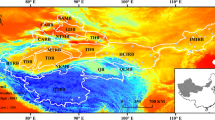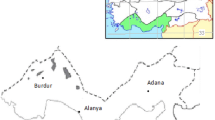Abstract
Taking into account reconstructed precipitation time series in Huashan mountain area of China on the one hand and sunspot numbers observations on the other hand, the authors used here continuous wavelet transform and cross wavelet transform to investigate possible connection between the two sets of indicators. The analysis was performed over the last 300 years: it is found that solar activity influences precipitation in that geographical area of China to some extent, with an excess of 5% statistical significance level red noise over the 11-year solar activity cycle.
Similar content being viewed by others
1 Introduction
Variations in solar activity affect Earth climate including atmospheric circulation, temperature and precipitation. After having studied the decadal oscillation in the ocean–atmosphere system in North Pacific with stepwise filtration, Qu et al. (2008) thought the solar activity triggered the oscillation. Based on the 10.7 cm solar flux data for 1948–2005 and the NCEP/NCAR reanalysis data, Duan (2008) analyzed the impact of solar activities on abnormality of atmospheric general circulation and results showed that solar activities have notable influence on summer middle- and high-level atmospheric circulation. Indian monsoon rainfall, an important component in the climate system of South Asia, was possibly influenced by solar activity (Bhattacharyya and Narasimha 2005; Ma et al. 2007). With computer simulation environment with neural network and stochastic analysis, Lucio (2005) thought solar activity response can be used as meteorological factors responsible for rainfall. Zhao et al. (2004) used continuous wavelet transform to examine relationship between solar activity and annual precipitation in Beijing of China. The results indicated that solar activity probably plays an important role in influencing precipitation on Beijing area.
Tree-ring has been employed successfully to reconstruct precipitation, streamflow (which integrates precipitation over an entire drainage basin) and other meteorological variables for many areas of the Earth. With spectral and wavelet analysis techniques, Rigozo et al. (2007) had investigated the solar activity signal in tree ring data from two locations in Chile. The Gleissberg cycle of tree ring data is in anti-phase with solar activity. Meanwhile the oscillations of tree-ring index are intermittent, possibly because solar activity signals observed in tree rings are mostly due to solar influence on local climate (rainfall, temperature, and cloud cover) where trees grow up. Feng and Han (2009) analyzed the variation of the tree-ring’s index of a platycladus orientalis at the Mausoleum of Emperor Huang during 1470–1974, it was determined that the 11-year cycle tree-ring is related to solar Schwabe cycle; the cycles of 90- and 150-year are likely to be related to solar Gleissberg cycle and Suess cycle. In this present paper, the authors apply wavelet techniques to investigate possible connection between solar activity and precipitation in Huashan mountain area of China on 11-year time scales during the last 300 years.
2 Description of the Data
Huashan mountain (34°29′N, 110°05′E), locating in Shaanxi Province, is in the central China. Shao and Wu (1994) collected Pinus armandi samples with long age from south peak, center peak and west peak in Huashan mountain area to establish the Huashan mountain tree-ring chronologies. Using tree-ring density and width from Pinus armandi, April–July (A–J) precipitation at Huashan mountain area had been reconstructed for the period during 1600–1988 (Hughes et al. 1994). Here the precipitation time series is taken from the National Climatic Data Center (NCDC).
Sunspots are regions on the solar surface that appear dark because they are cooler than the surrounding photosphere, and sunspot numbers are an important index of solar activity. The yearly relative sunspot numbers (SN) series used in this work is obtained from the Solar Influences Data Analysis Center (SIDC) at the Royal Observatory of Belgium. The data set covers the period of time from 1700 to 2006. The time series of precipitation and SN are shown on the bottom of Figs. 1, 2, respectively. Obvious correlation is not found from the figures, therefore wavelet transform is performed in next section to investigate possible connection between Huashan precipitation and solar variations.
The standardized time series of A–J precipitation (bottom) and its continuous wavelet power spectrum (top) during 1600–1988. The thick black contour designates the 5% significance level against red noise and the cone of influence (COI) where edge effects might distort the picture is shown as a blank region
3 Wavelet Analysis
Wavelets are a widely used class of functions used to localize a given function in both the time and frequency domains. By decomposing time series into time–frequency space, wavelet transform can lay out time-variable information of signals in both the time and frequency domains. In our study, we use continuous wavelet transform and cross wavelet transform to investigate possible connection between the precipitation in Huashan mountain area and solar variations.
3.1 Continuous Wavelet Transform
Morlet wavelet, as mother wavelet, is defined as,
Where ω 0 is dimensionless frequency and η is dimensionless time. The continuous wavelet transform (CWT) of a time series with uniform time step δt, is defined as the convolution of x n with the scaled and normalized wavelet. Corresponding wavelet transform is as follows:
We define the wavelet power as \( \left| {W_{n}^{X} (s)} \right|^{2} . \) Figure 1 displays wavelet power spectra of precipitation variations with wavelet scales from 2- to 128-year. There are several relatively obvious periodic signals with significant peaks on 2–8 years, about 11, 22 and 60 years with above the 5% significance level, though time span of corresponding precipitation is very short.
Similar to precipitation change, wavelet power spectra of SN series is shown in Fig. 2. Remarkable the 11-year oscillation is found in solar activity, with exceeding the 5% statistical significance level against red noise during almost whole time span.
In order to estimate possible influence of the 11-year solar cycle on precipitation variation, scale-averaged wavelet power of precipitation and SN over 8–16 years is made for each time epoch and the results are plotted in Fig. 3. Obviously, time-variable characteristics exist in the 11-year fluctuation signals of the two time series, and less consistent feature isn’t found. Specially, the precipitation variation reached the maximum in about 1900, however, the SN variation reached the maximum in about 1950. In order to clearly exhibit this complicated connection, we use cross wavelet transform and cross wavelet phase angle to analyze the two time series in the next section.
3.2 Cross Wavelet Transform
The cross wavelet transform (XWT) of two series x n and y n is defined as W XY=W X W Y *, and the XWT power is defined as |W XY|. Where, * denotes complex conjugation. The complex argument arg(W XY) can be interpreted as the local relative phase between x n and y n in time frequency space. The XWT power can reveal some areas with high common power (Grinsted et al. 2004). Figure 4 displays the XWT results of precipitation to SN time series.
The 11-year periodic fluctuation found from the individual wavelet transforms in Figs. 1, 2 is still very clear, and remarkable association exists in the two time series on this solar cycle in around 1800 and the period of time since 1860. However, the corresponding phase (arrows) is randomly distributed on the 11-year time scales.
4 Conclusion and Discussion
The results from wavelet analysis show there are a few periodic fluctuations (including 2–8, 11, 22 and 60 years) with intermittent time in precipitation series in Huashan mountain area of China. Cross wavelet analysis indicates complicated association between Huashan precipitation and solar variations. Remarkable association is found between precipitation and solar activity on 11-year time scales, with exceeding the 5% statistical significance level in about 1800 and the period of time since 1860.
According to studies of Shen et al. (2008), a centennial oscillation linkage was found in solar activity and summer precipitation variations in the eastern China during the last millennium. The precipitation variations of Longxi area, northeast margin of Tibetan plateau since AD 960 were analyzed. It showed that solar activity may be the main driving force of precipitation variations of Longxi on multi-decadal to centennial scales in the last millennium (Tan et al. 2007). As one of meteorological parameters in lower atmosphere, precipitation process in some region was influenced by solar variations through complex mechanisms including feedbacks reactions (Rozelot and Lefebvre 2002). In this work, Huashan locating in a mountainous area of North-Central China has peculiarly topographical characteristics. During vapor among air forming precipitation, there are some factors (such as wind, temperature, atmospheric pressure and landform) impacting precipitation variations. Solar irradiance variations resulting from many internal physical means inside the Sun, on all wavelengths (and so, not the total solar irradiance), cause global climatic changes likely through various processes in the upper troposphere-lower stratosphere region (Kodera and Kuroda 2002; Lefebvre et al. 2010). Many mechanisms can be involved, absorption and atmospheric circulation changes, modulation of the internal mode of variation in the polar night jets, changes in the Brewer–Dobson circulation, etc. Such physical links which need to be explored are today the only possible way to explain why the impact of solar activity on our climate, which is global, may influence only a regional geographical part. Huashan mountain is in transition zone between temperate monsoon climate and subtropical monsoon and monsoon humid climate, the precipitation in Huashan would be influenced from temperate monsoon climate, and tropical monsoon and monsoon humid climate is also more or less an impact on the precipitation. Meanwhile Huashan is a part as the eastern Qinling Mountains of China, its precipitation also has the characteristics of mountain precipitation. In the study of this issue, it is necessary to combine with regional characteristics when investigating precipitation in some area.
References
S. Bhattacharyya, R. Narasimha, Geophys. Res. Lett. 32, L05813 (2005)
C.C. Duan, Plateau. Mt. Meteorol. Res. 28, 37 (2008)
B. Feng, Y.B. Han, Sci. Chin. Ser. G-Phys. Mechan. Astron. 52, 631 (2009)
A. Grinsted, J.C. Moore, S. Jevrejeva, Nonlinear. Proc. Geophys. 11, 561 (2004)
M.K. Hughes, X.D. Wu, X.M. Shao, G.M. Garfin, Quat. Res. 42, 88 (1994)
K. Kodera, Y. Kuroda., J. Geophys. Res. 107(D24), 4749 (2002)
S. Lefebvre, C. Damiani et al., IAUS 264 symposium (Cambridge University Press, 2010), p. 301
P.S. Lucio, Geophys. Res. Lett. 32, L23819 (2005)
L.H. Ma, Y.B. Han, Z.Q. Yin, Appl. Geophys. 4, 1 (2007)
W.Z. Qu, F. Huang, J.P. Zhao, Y.L. Jia, C. Li, S.H. Yue, Oceanol. Limnol. Sinica. 39, 552 (2008)
N.R. Rigozo, D.J.R. Nordemann, M.P. Souza Echer et al., J. Atmos. Solar-Terre. Phys. 69, 1049 (2007)
J.P. Rozelot, S. Lefebvre, in Solar variability and geomagnetism, vol 1, ed. by Schröder (IAGA-IASPEI 2001 Assembly, 2002), p. 88
X.M. Shao, X.D. Wu, Acta. Geographica. Sinica. 49, 174 (1994)
C. Shen, W.C. Wang, Y. Peng, Y. Xu, J. Zheng, Clim. Past Discuss. 4, 611 (2008)
L. Tan, Y. Cai, L. Yi, Z. An, L. Ai, Clim. Past Discuss. 3, 1037 (2007)
J. Zhao, Y.B. Han, Z.A. Li, Chin. J. Astron. Astrophys. 4, 189 (2004)
Acknowledgments
The authors are grateful to SIDC and NCDC for providing the yearly sunspot number series and precipitation series respectively, and thank the reviewers for helpful comments which improved the manuscript greatly. Wavelet software is provided by C. Torrence and G. Compo, and is available at: http://paos.colorado.edu/research/wavelets/. Software by Grinsted, A., et al., is available at: http://www.pol.ac.uk/home/research/waveletcoherence/. This work has made use of the Astrophysics Data System (NASA) and is supported by the Young Researcher Grant of National Astronomical Observatories, Chinese Academy of Sciences.
Author information
Authors and Affiliations
Corresponding author
Rights and permissions
About this article
Cite this article
Ma, L.H., Han, Y.B. & Yin, Z.Q. Possible Influence of the 11-year Solar Cycle on Precipitation in Huashan Mountain of China over the Last 300 Years. Earth Moon Planets 107, 219–224 (2010). https://doi.org/10.1007/s11038-010-9367-y
Received:
Accepted:
Published:
Issue Date:
DOI: https://doi.org/10.1007/s11038-010-9367-y








